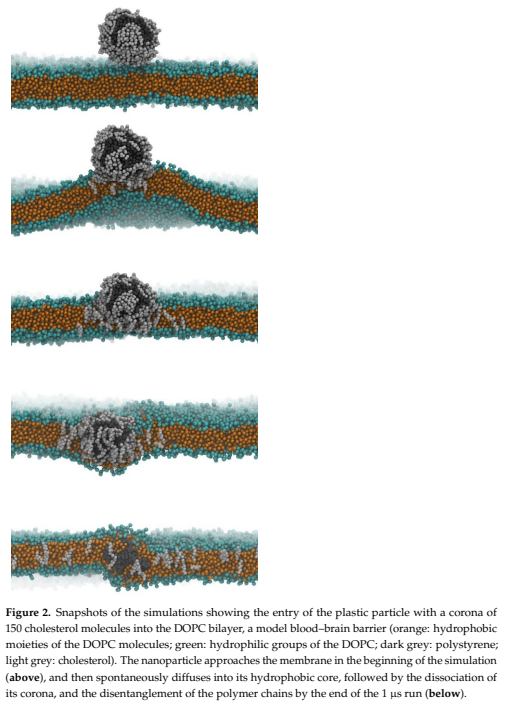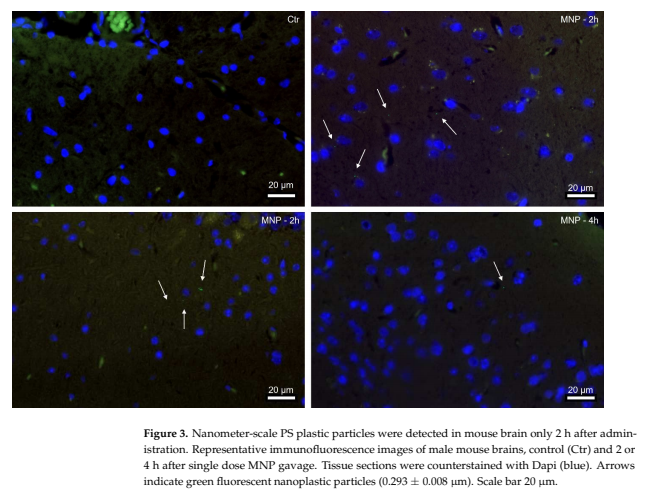Micro- and Nanoplastics Breach the Blood–Brain Barrier (BBB):
Biomolecular Corona’s Role Revealed
Nanomaterials 2023, 13, 1404. https://doi.org/10.3390/nano13081404https://www.mdpi.com/journal/nanomaterials

초록
인간은 섬유, 자동차 타이어 및 포장과 같은 고분자 재료에 지속적으로 노출됩니다.
불행하게도 그들의 분해 제품은 환경을 오염시켜 미세플라스틱 및 나노플라스틱(MNP)으로 광범위한 오염을 초래합니다.
혈액-뇌 장벽(BBB)은 유해 물질로부터 뇌를 보호하는 중요한 생물학적 장벽입니다.
본 연구에서는 폴리스티렌 미세/나노 입자(9.55 µm, 1.14 µm, 0.293 µm)를 경구 투여한 쥐에서 단기 흡수 연구를 수행했습니다.
우리는 더 큰 입자가 아닌 나노미터 크기의 입자가 위관 주입 후 단 2시간 이내에 뇌에 도달한다는 것을 보여줍니다. 전송 메커니즘을 이해하기 위해 다양한 코로나의 존재 및 부재에서 DOPC 이중층과 폴리스티렌 나노 입자의 상호 작용에 대한 성긴 분자 역학 시뮬레이션을 수행했습니다. 우리는 플라스틱 입자를 둘러싼 생체 분자 코로나의 구성이 BBB를 통과하는 데 중요하다는 것을 발견했습니다.
콜레스테롤 분자는 이러한 오염 물질이 BBB의 막으로 흡수되는 것을 강화한 반면, 단백질 모델은 이를 억제했습니다. 이러한 반대 효과는 입자가 뇌로 수동적으로 이동하는 것을 설명할 수 있습니다.
Abstract:
Humans are continuously exposed to polymeric materials such as in textiles, car tires and packaging.
Unfortunately, their break down products pollute our environment, leading to widespread contamination with micro- and nanoplastics (MNPs).
The blood–brain barrier (BBB) is an important biological barrier that protects the brain from harmful substances.
In our study we performed short term uptake studies in mice with orally administered polystyrene micro-/nanoparticles (9.55 µm, 1.14 µm, 0.293 µm).
We show that nanometer sized particles—but not bigger particles—reach the brain within only 2 h after gavage. To understand the transport mechanism, we performed coarsegrained molecular dynamics simulations on the interaction of DOPC bilayers with a polystyrene nanoparticle in the presence and absence of various coronae. We found that the composition of the biomolecular corona surrounding the plastic particles was critical for passage through the BBB.
Cholesterol molecules enhanced the uptake of these contaminants into the membrane of the BBB, whereas the protein model inhibited it. These opposing effects could explain the passive transport of the particles into the brain.



4. 결론
최근 몇 년 동안 플라스틱 오염은 점점 더 중요한 환경 및 인간 건강 문제가 되었습니다. 플라스틱 오염이 환경에 미치는 영향이 광범위하게 연구되었지만 인간을 포함한 포유류에 대한 플라스틱 소비의 잠재적인 건강 영향은 아직 밝혀지지 않았습니다. 생체분자 코로나는 생물학적 유체에 노출될 때 플라스틱 입자의 표면에 축적될 수 있는 단백질 및 기타 생체분자의 층입니다. 체내에 들어가기 전에 MNP는 생체분자, 유기물, 화학 및 생물학적 오염물질로 구성된 환경 또는 생태 코로나를 획득하여 코로나의 복잡하고 가변적인 구성에 기여합니다[8]. 따라서 코로나 유형은 BBB에 들어가는 능력과 전반적인 독성에 상당한 영향을 미칠 수 있습니다.
우리의 컴퓨터 모델은 PS 플라스틱 입자가 특정 표면 코로나에 따라 BBB에 들어가거나 교차할 수 있음을 보여주고 생체 내 마우스 모델은 이러한 결과를 확인하여 빠르면 2 h 노출 후. 이 연구는 또한 플라스틱 입자의 독성을 평가할 때 플라스틱 입자 표면의 "코로나"를 이해하는 것이 중요함을 강조했습니다. 플라스틱 입자 이동 메커니즘에 대한 이러한 새로운 통찰력은 인체 건강에 미치는 해로운 영향을 완화하기 위한 향후 연구 및 정책을 위한 귀중한 기반을 제공합니다. 일상 생활에서 플라스틱의 광범위한 사용과 미세플라스틱이 환경과 건강에 미치는 영향에 대한 우려가 커지면서 이 분야에 대한 더 많은 연구가 절실히 필요합니다. 플라스틱 입자 독성의 기본 메커니즘을 이해함으로써 우리는 플라스틱 소비와 관련된 위험을 줄이고 인간의 건강을 보호하기 위한 정책과 관행을 개발할 수 있습니다.
4. Conclusions
In recent years, plastic pollution has become an increasingly important environmental and human health issue. Although the environmental impacts of plastic pollution have been widely studied, the potential health consequences of plastic consumption on mammals including humans remain to be elucidated. The biomolecular corona is a layer of proteins and other biomolecules that can accumulate on the surface of plastic particles when they are exposed to biological fluids. Before entering the body, MNPs acquire an environmental or eco-corona consisting of biomolecules, organic matter and chemical and biological contaminants, contributing to the corona’s complex and variable composition [8]. The type of corona can therefore significantly impact their ability to enter the BBB and their overall toxicity.
Our computer models show that PS plastic particles are able to enter/cross the BBB depending on their specific surface corona, and in vivo mouse models verified these findings, showing accumulations of specifical signals of nanometer-sized PS particles in brain tissues as early as 2 h after exposure. The research also highlighted the importance of understanding the “corona” on the surface of plastic particles when assessing their toxicity. These new insights into the mechanisms for plastic particle transfer provide a valuable foundation for future research and policies aimed at mitigating their harmful effects on human health. Given the widespread use of plastics in our daily lives and the growing concern over the impact of microplastics on the environment and our health, there is an urgent need for more research in this field. By understanding the underlying mechanisms of plastic particle toxicity, we can develop policies and practices to reduce the risks associated with plastic consumption and protect human health.
#polystyrene #micro-nanoplastic #blood–brain barrier #bbb #biomolecular corona #computational uptake modeling
Nanomaterials 2023, 13, 1404. https://doi.org/10.3390/nano13081404https://www.mdpi.com/journal/nanomaterials